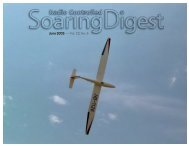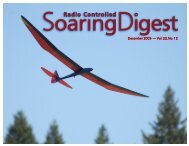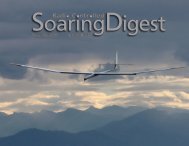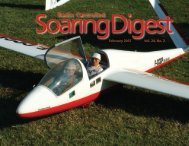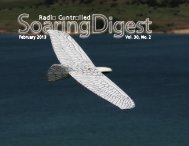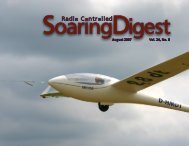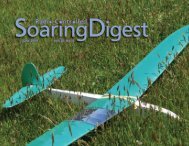August 2006 Vol. 23, No. 8 – R/C - RCSoaring.com
August 2006 Vol. 23, No. 8 – R/C - RCSoaring.com
August 2006 Vol. 23, No. 8 – R/C - RCSoaring.com
Create successful ePaper yourself
Turn your PDF publications into a flip-book with our unique Google optimized e-Paper software.
three locations on the wing/wing saddle.<br />
Mark Miller also suggests using a small<br />
fender washer under the aft bolt to spread<br />
the loads as needed.<br />
For the ballast, I made a trip to the local<br />
gun shop and looked at reloading supplies,<br />
settling on.44 caliber lead balls used for<br />
muzzle loaders as a near perfect fit for the<br />
inside diameter of the Kevlar ballast tubes.<br />
The ones I bought are actually 0.451" in<br />
diameter and are a nice fit in the ballast<br />
tubes. Each ballast tube will accept eight<br />
ounces for a 16 ounce total. This increases<br />
the all up weight of the Soprano by 31%,<br />
with the wing loading topping out at 10<br />
ounces/sq. ft.<br />
You could probably improve on additional<br />
weight by using slugs but the balls load<br />
easily and quickly when I’m out at the<br />
flying field and I’m not worried about<br />
them hanging up in the tubes.<br />
SET-UP:<br />
In setting up the control throws, I used all<br />
of the available rudder movement - this is<br />
limited by the live hinge and wiper. The<br />
control horn mounts on the left or wiper<br />
side of the rudder and as such, there is the<br />
rudder thickness to take into<br />
consideration. I installed the control horn<br />
so that the linkage is 0.25" off of the<br />
surface. Be sure to mount the horn itself so<br />
that the rudder can fully deflect without<br />
the horn itself butting up against the<br />
vertical fin. I was able to get a full 1.00"<br />
inch movement both ways, measured at<br />
the base of the rudder.<br />
The elevator was set up with a range of<br />
0.625"” up and 0.375” down. The spoiler<br />
is rather large and mounted on the<br />
centerline, so it likely would have an<br />
impact on the tail surfaces. Initially I had it<br />
open 0.75" at the trailing edge and did not<br />
program elevator <strong>com</strong>pensation into the<br />
radio.<br />
TEST FLYING:<br />
With the Soprano <strong>com</strong>pleted and ready to<br />
go, I then had nearly two months to wait<br />
before decent weather and my available<br />
time allowed me to head off to the field.<br />
First flights were simply to define the CG<br />
and get a feel for the Soprano. I started<br />
with the CG at 3.375” behind the wing<br />
leading edge and the towhook set at 3.25"<br />
behind the wing leading edge. Launches<br />
were good with no worries about zooming<br />
at the top. The speed range was impressive<br />
for an RES model though the MH32 is not<br />
meant to be flown like a flat bottom airfoil<br />
and needs to carry a bit more speed than a<br />
typical RES model. The spoiler is indeed<br />
very powerful, so be sure to take care<br />
when setting your Soprano up.<br />
When it was time to pack up and head<br />
home, I was quite satisfied that I had a very<br />
good model with the Soprano.<br />
My next trip to the field was on a day with<br />
little to no breeze, with most puffs being<br />
thermal induced. This allowed me to work<br />
on the CG and elevator settings. I settled<br />
on a CG 3.5" aft of the leading edge of the<br />
wing and a towhook set 3.375" back from<br />
the leading edge of the wing<br />
I found that the Soprano allowed me to<br />
cover a fair amount of sky looking for lift<br />
and once found, trim in some additional<br />
up elevator and work the thermal for best<br />
climb rate. I even managed to climb out<br />
from around 20 feet and sky out the<br />
Soprano, something that impressed me<br />
and the other club members watching at<br />
the field.<br />
CONTEST PERFORMANCE:<br />
Our club had its big weekend contest in<br />
mid-June and I decided to fly the Soprano<br />
on both days. The event is part of the Ohio<br />
Valley Soaring Society’s (OVSS for short)<br />
Midwest series and, as such, there would<br />
be some very <strong>com</strong>petent fliers in<br />
attendance. Saturday turned into a real<br />
blow out with winds building throughout<br />
the morning to over 20mph with gusts<br />
even higher. After two rounds, I called it<br />
quits as I was not willing to risk a new<br />
model in those blustery conditions.<br />
Sunday turned out to be a much better day<br />
with winds 7 to 15 m.p.h. through most of<br />
the day, with winds at altitude somewhat<br />
higher. I chose to fly with a half load of<br />
ballast which turned out to be a wise<br />
choice as it allowed the Soprano to range<br />
about in search of lift and still work the<br />
small patches when they were found.<br />
With the man on man format being used<br />
for the contest, I managed a number of<br />
10 R/C Soaring Digest




